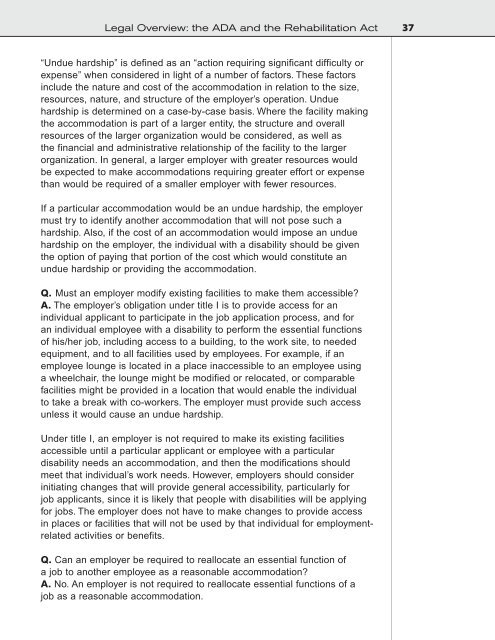Design for Accessibility: A Cultural Administrator's Handbook
Design for Accessibility: A Cultural Administrator's Handbook
Design for Accessibility: A Cultural Administrator's Handbook
Create successful ePaper yourself
Turn your PDF publications into a flip-book with our unique Google optimized e-Paper software.
Legal Overview: the ADA and the Rehabilitation Act 37<br />
“Undue hardship” is defined as an “action requiring significant difficulty or<br />
expense” when considered in light of a number of factors. These factors<br />
include the nature and cost of the accommodation in relation to the size,<br />
resources, nature, and structure of the employer’s operation. Undue<br />
hardship is determined on a case-by-case basis. Where the facility making<br />
the accommodation is part of a larger entity, the structure and overall<br />
resources of the larger organization would be considered, as well as<br />
the financial and administrative relationship of the facility to the larger<br />
organization. In general, a larger employer with greater resources would<br />
be expected to make accommodations requiring greater ef<strong>for</strong>t or expense<br />
than would be required of a smaller employer with fewer resources.<br />
If a particular accommodation would be an undue hardship, the employer<br />
must try to identify another accommodation that will not pose such a<br />
hardship. Also, if the cost of an accommodation would impose an undue<br />
hardship on the employer, the individual with a disability should be given<br />
the option of paying that portion of the cost which would constitute an<br />
undue hardship or providing the accommodation.<br />
Q. Must an employer modify existing facilities to make them accessible?<br />
A. The employer’s obligation under title I is to provide access <strong>for</strong> an<br />
individual applicant to participate in the job application process, and <strong>for</strong><br />
an individual employee with a disability to per<strong>for</strong>m the essential functions<br />
of his/her job, including access to a building, to the work site, to needed<br />
equipment, and to all facilities used by employees. For example, if an<br />
employee lounge is located in a place inaccessible to an employee using<br />
a wheelchair, the lounge might be modified or relocated, or comparable<br />
facilities might be provided in a location that would enable the individual<br />
to take a break with co-workers. The employer must provide such access<br />
unless it would cause an undue hardship.<br />
Under title I, an employer is not required to make its existing facilities<br />
accessible until a particular applicant or employee with a particular<br />
disability needs an accommodation, and then the modifications should<br />
meet that individual’s work needs. However, employers should consider<br />
initiating changes that will provide general accessibility, particularly <strong>for</strong><br />
job applicants, since it is likely that people with disabilities will be applying<br />
<strong>for</strong> jobs. The employer does not have to make changes to provide access<br />
in places or facilities that will not be used by that individual <strong>for</strong> employmentrelated<br />
activities or benefits.<br />
Q. Can an employer be required to reallocate an essential function of<br />
a job to another employee as a reasonable accommodation?<br />
A. No. An employer is not required to reallocate essential functions of a<br />
job as a reasonable accommodation.


